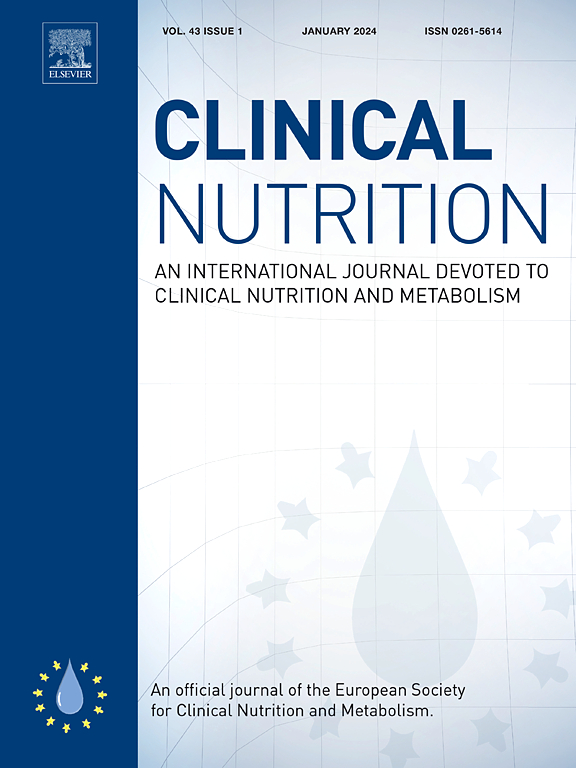体重指数和饮食模式之间的相互作用对严重非酒精性脂肪肝发病率的影响:前瞻性队列研究。
IF 7.4
2区 医学
Q1 NUTRITION & DIETETICS
引用次数: 0
摘要
背景:膳食模式与非酒精性脂肪肝(NAFLD)之间的关系是否因体重指数(BMI)而异尚不清楚。我们旨在探索膳食模式与严重非酒精性脂肪肝发病率之间的关系,并进一步研究体重指数与膳食模式之间的相互作用:在一项利用英国生物库数据进行的前瞻性队列研究中,我们纳入了具有基线食物频率问卷(FFQ)信息的白人参与者。采用主成分分析(PCA)和方差旋转法确定主要饮食模式。主要结果是严重非酒精性脂肪肝,即因非酒精性脂肪肝或非酒精性脂肪性肝炎(NASH)住院。我们采用了针对竞争风险的特定原因 Cox 回归来评估相关性,并计算了相互作用导致的相对超额风险 (RERI),以估计 BMI 的相互作用:本研究共纳入 307130 名参与者,中位随访时间为 12.68 年。共发现 3104 例严重非酒精性脂肪肝病例。PCA 分析显示了两种主要饮食模式:谨慎饮食(RC1)和肉类饮食(RC2)。多变量分析显示,RC1 标准差(SD)的增加与较低的严重非酒精性脂肪肝风险相关(HR 0.91 [95 % CI 0.88 至 0.94]),而 RC2 标准差的增加与较高的风险相关(1.10 [1.05 至 1.14])。基线体重指数≥25 kg/m2与饮食模式之间存在显著的相互作用(RC1:RERI:-0.22 [95 % CI -0.43 to -0.003];RC2:0.29 [0.03 to 0.56]):考虑到在体重指数和膳食模式之间观察到的显著交互作用,有针对性的膳食调整对有严重非酒精性脂肪肝风险的特定人群至关重要。本文章由计算机程序翻译,如有差异,请以英文原文为准。
Effects of the interaction between body mass index and dietary patterns on severe NAFLD incidence: A prospective cohort study
Background
It remains unclear whether the associations between dietary patterns and non-alcoholic fatty liver disease (NAFLD) vary by body mass index (BMI). We aimed to explore the association between dietary patterns and severe NAFLD incidence, and further investigate the interaction of BMI with dietary patterns.
Methods
In a prospective cohort study using UK Biobank data, we included White participants with baseline food frequency questionnaire (FFQ) information. Principal component analysis (PCA) with varimax rotation was performed to identify major dietary patterns. The primary outcome was severe NAFLD, defined as hospitalization due to NAFLD or non-alcoholic steatohepatitis (NASH). We employed cause-specific Cox regression for competing risks to assess the association and calculated the relative excess risk due to interaction (RERI) to estimate the interaction of BMI.
Results
This study included 307,130 participants with a median follow-up of 12.68 years. 3104 cases of severe NAFLD were identified. PCA analysis revealed two primary dietary patterns: a prudent diet (RC1) and a meat-based diet (RC2). Multivariate analysis showed a standard deviation (SD) increase in RC1 was associated with lower severe NAFLD risk (HR 0.91 [95 % CI 0.88 to 0.94]), while a SD increase in RC2 was associated with higher risk (1.10 [1.05 to 1.14]). Significant interactions were observed between baseline BMI ≥25 kg/m2 and dietary patterns (RC1: RERI: −0.22 [95 % CI –0.43 to −0.003]; RC2: 0.29 [0.03 to 0.56]).
Conclusions
Targeted dietary modifications are vital for specific populations at risk of severe NAFLD, considering the significant interaction observed between BMI and dietary patterns.
求助全文
通过发布文献求助,成功后即可免费获取论文全文。
去求助
来源期刊

Clinical nutrition
医学-营养学
CiteScore
14.10
自引率
6.30%
发文量
356
审稿时长
28 days
期刊介绍:
Clinical Nutrition, the official journal of ESPEN, The European Society for Clinical Nutrition and Metabolism, is an international journal providing essential scientific information on nutritional and metabolic care and the relationship between nutrition and disease both in the setting of basic science and clinical practice. Published bi-monthly, each issue combines original articles and reviews providing an invaluable reference for any specialist concerned with these fields.
 求助内容:
求助内容: 应助结果提醒方式:
应助结果提醒方式:


